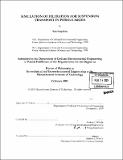| dc.contributor.advisor | Andrew J. Whittle. | en_US |
| dc.contributor.author | Kim, Yun Sung, 1974- | en_US |
| dc.contributor.other | Massachusetts Institute of Technology. Dept. of Civil and Environmental Engineering. | en_US |
| dc.date.accessioned | 2006-03-24T18:28:19Z | |
| dc.date.available | 2006-03-24T18:28:19Z | |
| dc.date.copyright | 2005 | en_US |
| dc.date.issued | 2005 | en_US |
| dc.identifier.uri | http://hdl.handle.net/1721.1/30187 | |
| dc.description | Thesis (Ph. D.)--Massachusetts Institute of Technology, Dept. of Civil and Environmental Engineering, 2005. | en_US |
| dc.description | Page 308 blank. | en_US |
| dc.description | Includes bibliographical references (p. 295-307). | en_US |
| dc.description.abstract | This thesis describes the development and application of a novel method for analyzing the filtration of particles transported through a granular porous medium. The proposed analysis considers the deposition of particles through discrete simulations of particle-laden flow in a cylindrical model pore. The pore model assumes that particles collect, mound up and ultimately clog the pore under the action of hydrodynamic and gravitational forces. By simulating particle deposition processes at the pore scale, the current analyses provide a more realistic physical framework for interpreting filtration experiments than conventional continuum models that implicitly assume length scales much larger than the pores. A detailed parametric study has established relationships between the collection efficiency, mound height and deposit depth as functions of the model pore dimensions, orientation (relative to the gravitational field) and particle settling velocity for injection at constant flow rate. The results showed that the maximum mound height and deposit depth can be correlated with the pressure difference necessary to maintain flow through the model pore. A quasi one-dimensional network 'bubble' model (Datta and Redner, 1998) was developed to simulate 1-D suspension transport problems. The bubble model comprises a serial linkage of bundles of cylindrical bonds with shared nodes at each end. Bubble model simulations include distribution functions for the pore dimensions. Filtration in an individual bond is characterized by correlations from the model pore simulations. | en_US |
| dc.description.abstract | The bubble model has been applied to interpret filtration data from two sets of column experiments: acrylic particle transport through glass beads by Yoon et al. (2004), and microfine cement suspension through a sand bed by Bouchelaghem and Vulliet (2001). It was found that the collection efficiency obtained from model pore simulations overestimates the measured filtration rates due to detachment process that are not considered in the parametric study. Two empirical parameters, attachment probability and detachment rate were employed to partition the deposited particles between those firmly attached and those detachable, and its rate of re-entrainment. With these parameters, the bubble model produced successful predictions of measured temporal and spatial filtration extent in column tests that have proved difficult to simulate with continuum models. | en_US |
| dc.description.statementofresponsibility | by Yun Sung Kim. | en_US |
| dc.format.extent | 308 p. | en_US |
| dc.format.extent | 14644532 bytes | |
| dc.format.extent | 14685932 bytes | |
| dc.format.mimetype | application/pdf | |
| dc.format.mimetype | application/pdf | |
| dc.language.iso | eng | en_US |
| dc.publisher | Massachusetts Institute of Technology | en_US |
| dc.rights | M.I.T. theses are protected by copyright. They may be viewed from this source for any purpose, but reproduction or distribution in any format is prohibited without written permission. See provided URL for inquiries about permission. | en_US |
| dc.rights.uri | http://dspace.mit.edu/handle/1721.1/7582 | |
| dc.subject | Civil and Environmental Engineering. | en_US |
| dc.title | Simulation of filtration for suspension transport in porous media | en_US |
| dc.type | Thesis | en_US |
| dc.description.degree | Ph.D. | en_US |
| dc.contributor.department | Massachusetts Institute of Technology. Department of Civil and Environmental Engineering | |
| dc.identifier.oclc | 60685973 | en_US |
